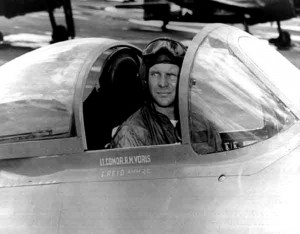By: Deb Smith

Retired Navy Capt. Roy M. “Butch” Voris, creator of the U.S. Navy’s Blue Angels precision flying team, passed away following an extended illness Aug. 9, at his home in Monterey, Calif.
Retired Navy Capt. Roy M. “Butch” Voris, decorated World War II Ace and founder of the U.S. Navy’s Blue Angels precision flying team, passed away following an extended illness Aug. 9, at his home in Monterey, Calif. He was 86.
Voris served in the Navy for more than three decades, and earned three Distinguished Flying Crosses, 11 Air Medals, three Presidential Unit Citations, and the Purple Heart. His status as an ace was confirmed in the Pacific theater where he shot down eight Japanese fighter planes. Flying from the carriers “USS Enterprise” and “USS Hornet,” he fought in the battles of Santa Cruz, Guadalcanal, Tarawa, Central Pacific Islands, Philippine Sea, the Great Marianas Turkey Shoot, and “The Mission into Darkness,” a special operation during the Battle of the Philippine Sea in which Navy planes were launched near dusk to prey on the Japanese fleet—anticipating most would be too low on fuel to make it to shore.
Born Sept. 19, 1919, in Los Angeles, Voris graduated from Santa Cruz High School, and later from Salinas Junior College. He had at one time pondered a career as a mortician, but instead joined the Navy in 1941.
He was in flight school when the Japanese bombed Pearl Harbor on Dec. 7. He went on to hone his skills as a pilot. His accomplishments eventually caught the eye of Adm. Chester Nimitz, who in 1946 instructed Voris to assemble an aerial demonstration team that would “rival the Army Air Corps” and “keep the public interested in naval aviation.”
Later that year, on June 15, Voris led the newly formed team, comprised of hand-picked pilots who were also Pacific War veterans-—Nick Wickendoll, Bob Clark, Al Tadeo, and Billy May—in their first public performance at Craig Field in Jacksonville, Fla., flying Grumman F-6F Hellcats.
It was a breathtaking show lasting almost 15 minutes. Three Hellcats, roaring across the sky, wingtip to wingtip, performed aerobatic rolls and maneuvers that were second nature to combat, but seldom ever seen by the public.
Voris called the group the Blue Angels, after an advertisement he saw for a New York nightclub in New Yorker magazine. He insisted, despite its origin, that the name “just sounded right.”
For the next six years, Voris and his band of “blue brothers” would delight crowds and more than fulfill Adm. Nimitz’s mission of keeping the public interested in naval aviation.
But it wasn’t without the obligatory growing pains. With another war looming—this time in Korea—it was evident the Navy would need “all hands on deck.” And that included the Blue Angels.
Declared combat ready in late 1950, the Blue Angels comprised a major portion of VF-191, and gave themselves the moniker “Satan’s Kittens.” It was during this time the team would experience its first fatality of war. Lt. Cdr. Johnny Magda was shot down while flying a combat mission over Korea.
While the Korean War raged on, the Department of the Navy decided there was still a very viable need to maintain the public’s confidence—and keep recruiting quotas on track. So, the boys in blue were brought back in June 1952 to pick up where they left off.
That meant bringing “Butch” Voris back for a second time to reform the team. Although Voris had survived many close calls during World War II—including a Japanese bullet zipping through the bottom of his cockpit—Voris would experience yet another dance with the Grim Reaper.
An exceptional pilot with great stamina and “a good head” on his shoulders, Voris had emerged from numerous accidents and emergency situations. During a Blue Angel demonstration at Corpus Christi, Texas, in 1952, the 33-year-old flight leader miraculously survived a midair collision. The incident took the life of one Blue Angel, but Voris managed to nurse his plane back to earth despite the lack of control and a completely severed tail.
A highly decorated sailor, Voris retired from the Navy in 1963. He moved to Bethpage, N.Y., where he was hired as an executive for the Grumman Aircraft Corporation, and was instrumental in the early development of the F-14 Tomcat.
Voris went on to become a popular spokesperson for NASA in the 1970s, enthusiastically promoting the organization and spreading his contagious excitement during the early Apollo missions.
He’s been honored many times over for his contributions to aviation, including his enshrinement into the Navy Aviation Hall of Fame in Pensacola, Fla., as well as the International Air Show Hall of Fame. There’s even an aircraft bearing his name located outside Jacksonville Naval Air Station-—and the passenger terminal there is also named for him.
In 1993, Voris was singled out by the United States Air Force with a “Gathering of Eagles” ceremony where he was named as one of only 20 pilots worldwide who have made significant contributions to aviation. The 2004 California Air Show at Salinas, Calif., was dedicated in his honor.
“First Blue,” the story of Voris’ life, written by Robert Wilcox, with a forward by astronaut James Lovell, was published by St. Martins Press in 2004.











